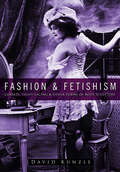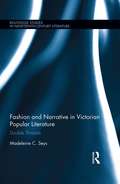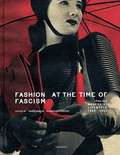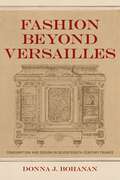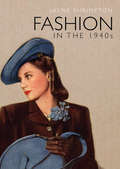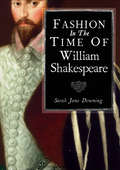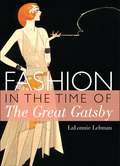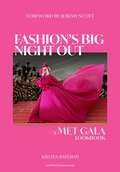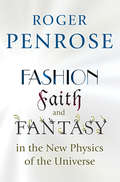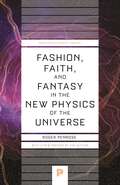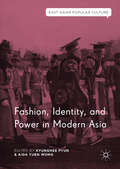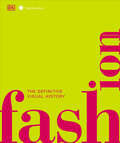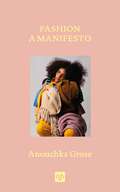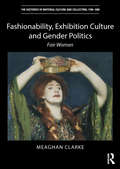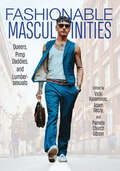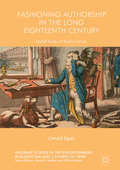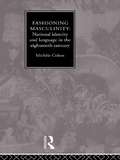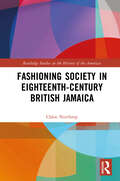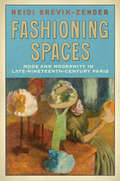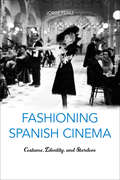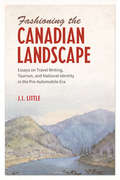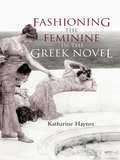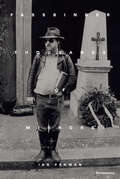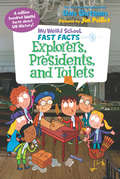- Table View
- List View
Fashion and Fetishism: Corsets, Tight-Lacing and Other Forms of Body-Sculpture
by David KunzlePresenting the history of corsetry and body sculpture, this edition shows how the relationship between fashion and sex is closely bound up with sexual self-expression. It demonstrates how the use of the corset rejected the role of the passive, maternal woman, so that in Victorian times it was seen as a scandalous threat to the social order.
Fashion and Narrative in Victorian Popular Literature: Double Threads (Routledge Studies in Nineteenth Century Literature)
by Madeleine C. SeysWe know that way we dress says a lot about us. It’s drilled into us by our parents as children, as adults throughout our working lives, and eternally from the culture surrounding us. Our dress tells the outside world of the culture and era we come from to our social status within that culture. Our dress can be telling of our political views, religious beliefs, sexuality and countless other identifying traits that we can keep hidden or show to the world by our choice of what to wear when heading venturing out. This was absolutely true, famously so, in the Victorian Era in which men and women alike wore their status on their often lavish, embellished sleeves. In her new book, Dr. Madeleine Seyes explores Victorian culture through the lens of fashion in her new book, Double Threads: Fashion and Victorian Popular Literature, which sits at the intersection of the fields of Victorian literary studies, dress and material cultural studies, feminist literary criticism, and gender and sexuality studies.
Fashion at the Time of Fascism: Italian Modernist Lifestyle Between, 1922-1943
by Mario Lupano Alessandra VaccariThe first visual history of Modernist Italian fashion during Benito Mussolini's Fascist regime, and the product of immense research, Fashion at the Time of Fascism charts the fashion industry's ambivalent negotiation of international couture and the bizarre dictates of Fascism, and the legacy of this era in shaping today's fashion industry. Authors Mario Lupano and Alessandra Vaccari explore and compare a huge range of forgotten archival sources, such as women's glossies, fashion, film and gossip magazines, photo archives, exhibition and commercial catalogues, books, manuals and magazines on tailoring, dressmaking, design and architecture, and corporate and government journals. This abundance of materials is presented in a fluid sequence of image and text that charts the rhythms, rituals and lifestyles of the typical Italian day through the four basic themes of "Measurements," "Model," "Brand" and "Parade." Each section includes texts that highlight the key figures and phases in Italian fashion, from the 1920s to the early 1940s, juxtaposing them with Modernism's broader salient themes and emphasizing the conscious use of glamour in the regime's super-choreographed portrayal of itself. Fashion at the Time of Fascism is further enriched by a thorough iconographic index and a detailed reference list, making the volume a revelation for both general readers and scholars.
Fashion beyond Versailles: Consumption and Design in Seventeenth-Century France
by Donna J. BohananAs the epicenters of style and innovation, the cities of Paris and Versailles dominate studies of consumerism in seventeenth-century France, but little scholarship exists on the material culture, fashion, and consumption patterns in the provinces. Donna J. Bohanan's Fashion beyond Versailles fills this historiographical gap by examining the household inventories of French nobles and elites in the southern province of Dauphiné.Much more than a simple study of the decorative arts, Fashion beyond Versailles investigates the meaning of material ownership. By examining postmortem registries and archival publications, Bohanan reveals the social imperatives, local politics, and high fashion trends that spurred the consumption patterns of provincial communities.In doing so, she reveals a closer relationship between consumer behavior of Versailles and the provinces than most historians have maintained. Far-reaching in its sociological and psychological implications, Fashion beyond Versailles both makes use of and contributes to the burgeoning literature on material culture, fashion, and consumption.
Fashion in the 1940s
by Jayne ShrimptonThis book reveals the impact of wartime on British fashion, how a spirit of utility, make-do and mend unleashed a whole new creativity among Britain's women starved of high fashion by rationing. Many of these home dressmakers copied the high-end looks. Women doing war work created new street fashion looks. It also shows how world war shifted the centre of the international fashion from Paris to New York and established a casual American style for British women and men. Finally, we see the re-birth of Paris fashion in Dior's New Look and a new glamour.
Fashion in the Time of William Shakespeare
by Sarah DowningGarments and accessories are prominent in almost all of William Shakespeare's plays, from Hamlet and Othello to A Midsummer Night's Dream and Twelfth Night. The statement 'the apparel oft proclaims the man' was one that would have resonated with their audiences: the rise of England's merchant class had made issues of rank central to Elizabethan debate, and a rigid table of sumptuary laws carefully regulated the sorts of fabric and garment worn by the different classes. From the etiquette of courtly dress to the evolution of the Elizabethan ruff, in this vibrant introduction Sarah Jane Downing explores the sartorial world of the late sixteenth century, why people wore the clothes they did, and how the dizzying eclectic range of fashions (including ruffs, rebatos and French farthingales) transformed over time.
Fashion in the Time of the Great Gatsby
by Lalonnie LehmanThe Great Gatsby is that rare classic that inescapably defines the age from which it sprang: the Roaring '20s, an era of economic boom, stylish excess and above all an explosion of new and exciting fashions. This book chronicles the sparkling spectacle of Jazz Age fashion as it moves from the corseted world of the 1910s to flapper dresses, fedoras and bejeweled headbands. Illustrated with period photographs, designer sketches and key excerpts from The Great Gatsby novel, the book fully captures the style and glamour of the age of Jay Gatsby and Daisy Miller. It spans the entire wardrobe of both men and women, including day and evening wear, accessories, casual attire and "fads" like smoking jackets, tiaras and cigarette holders.
Fashion's Big Night Out: A Met Gala Lookbook
by Kristen BatemanThe Met Gala or Met Ball is one of the world's biggest events for celebrity, fashion and pop culture. Founded by Eleanor Lambert, and organised by Vogue, it began in 1948 as an annual fundraising gala held for the benefit of the Metropolitan Museum of Art's Costume Institute in New York, raising more than $200 million to date. And Anna Wintour is in charge.An irresistible invitation to this annual stunning spectacle, Fashion's Big Night Out is the perfect gift for celebrity and fashion fans alike. Just as important as the costume exhibition is the star-studded red-carpet and the depth of global interest this generates. Alongside the costumes, couture story, and social/celebrity context, the book showcases all the extravagant and risk-taking fashion and celebrity moments that have graced this fabulous red carpet in the 21st century.
Fashion's Big Night Out: A Met Gala Lookbook
by Kristen BatemanThe Met Gala or Met Ball is one of the world's biggest events for celebrity, fashion and pop culture. Founded by Eleanor Lambert, and organised by Vogue, it began in 1948 as an annual fundraising gala held for the benefit of the Metropolitan Museum of Art's Costume Institute in New York, raising more than $200 million to date. And Anna Wintour is in charge.An irresistible invitation to this annual stunning spectacle, Fashion's Big Night Out is the perfect gift for celebrity and fashion fans alike. Just as important as the costume exhibition is the star-studded red-carpet and the depth of global interest this generates. Alongside the costumes, couture story, and social/celebrity context, the book showcases all the extravagant and risk-taking fashion and celebrity moments that have graced this fabulous red carpet in the 21st century.
Fashion, Faith, and Fantasy in the New Physics of the Universe
by Roger PenroseWhat can fashionable ideas, blind faith, or pure fantasy possibly have to do with the scientific quest to understand the universe? Surely, theoretical physicists are immune to mere trends, dogmatic beliefs, or flights of fancy? In fact, acclaimed physicist and bestselling author Roger Penrose argues that researchers working at the extreme frontiers of physics are just as susceptible to these forces as anyone else. In this provocative book, he argues that fashion, faith, and fantasy, while sometimes productive and even essential in physics, may be leading today's researchers astray in three of the field's most important areas--string theory, quantum mechanics, and cosmology.Arguing that string theory has veered away from physical reality by positing six extra hidden dimensions, Penrose cautions that the fashionable nature of a theory can cloud our judgment of its plausibility. In the case of quantum mechanics, its stunning success in explaining the atomic universe has led to an uncritical faith that it must also apply to reasonably massive objects, and Penrose responds by suggesting possible changes in quantum theory. Turning to cosmology, he argues that most of the current fantastical ideas about the origins of the universe cannot be true, but that an even wilder reality may lie behind them. Finally, Penrose describes how fashion, faith, and fantasy have ironically also shaped his own work, from twistor theory, a possible alternative to string theory that is beginning to acquire a fashionable status, to "conformal cyclic cosmology," an idea so fantastic that it could be called "conformal crazy cosmology."The result is an important critique of some of the most significant developments in physics today from one of its most eminent figures.
Fashion, Faith, and Fantasy in the New Physics of the Universe (Princeton Science Library)
by Roger PenroseNobel Prize–winning physicist Roger Penrose questions some of the most fashionable ideas in physics today, including string theoryWhat can fashionable ideas, blind faith, or pure fantasy possibly have to do with the scientific quest to understand the universe? Surely, theoretical physicists are immune to mere trends, dogmatic beliefs, or flights of fancy? In fact, acclaimed physicist and bestselling author Roger Penrose argues that researchers working at the extreme frontiers of physics are just as susceptible to these forces as anyone else. In this provocative book, he argues that fashion, faith, and fantasy, while sometimes productive and even essential in physics, may be leading today's researchers astray in three of the field's most important areas—string theory, quantum mechanics, and cosmology.Arguing that string theory has veered away from physical reality by positing six extra hidden dimensions, Penrose cautions that the fashionable nature of a theory can cloud our judgment of its plausibility. In the case of quantum mechanics, its stunning success in explaining the atomic universe has led to an uncritical faith that it must also apply to reasonably massive objects, and Penrose responds by suggesting possible changes in quantum theory. Turning to cosmology, he argues that most of the current fantastical ideas about the origins of the universe cannot be true, but that an even wilder reality may lie behind them. Finally, Penrose describes how fashion, faith, and fantasy have ironically also shaped his own work, from twistor theory, a possible alternative to string theory that is beginning to acquire a fashionable status, to "conformal cyclic cosmology," an idea so fantastic that it could be called "conformal crazy cosmology."The result is an important critique of some of the most significant developments in physics today from one of its most eminent figures.
Fashion, Identity, and Power in Modern Asia (East Asian Popular Culture)
by Kyunghee Pyun Aida Yuen WongThis edited volume on radical dress reforms in East Asia takes a fresh look at the symbols and languages of modernity in dress and body. Dress reform movements around the turn of the twentieth century in the region have received little critical attention as a multicultural discourse of labor, body, gender identity, colonialism, and government authority. With contributions by leading experts of costume/textile history of China, Korea, and Japan, this book presents up-to-date scholarship using diverse methodologies in costume history, history of consumption, and international trade. Thematically organized into sections exploring the garments and uniforms, accessories, fabrics, and fashion styles of Asia, this edited volume offers case studies for students and scholars in an ever-expanding field of material culture including, but not limited to, economic history, visual culture, art history, history of journalism, and popular culture. Fashion, Identity, and Power in Modern Asia stimulates further research on the impact of modernity and imperialism in neglected areas such as military uniform, school uniform, women’s accessories, hairstyles, and textile trade.
Fashion, New Edition: The Definitive Visual Guide (DK Definitive Cultural Histories)
by DKThe definitive guide to the history of fashion.From Ancient Egypt and Marie Antionette to Alexander McQueen and Chanel, this visually stunning fashion design book charts the evolution of clothing and shows how every generation reinvents fashion! The perfect fashion coffee table book! Here&’s what you&’ll find inside: • Covers the most important fashion periods in vivid detail, from ancient times to the present day, in extensive catalog spreads • From a crinoline to a Givenchy gown, specially photographed &“virtual tours&” of classic pieces spotlight the details that make up a masterpiece • Profiles showcase the key styles and works of trailblazing designers, describing how they have influenced the clothes we wear • Beautiful double-page images from fashion archives show how people have embraced fashion in every era and place fashion in its cultural context The fashion industry is yours to explore! Packed with a dazzling combination of original fashion plates, archive images and commissioned photography, Fashion takes you on a fabulous tour across the centuries! It catalogs the history of what people wear — revealing how Western fashion has been influenced by design from around the world — and celebrating everything from costumes to haute couture.Now fully revised and updated, this lavishly illustrated book about fashion includes recent subjects of interest including the increased role of social media, fast fashion, sustainable fashion, and the drive for improved diversity and beauty ideals. The illustrated glossary of technical terms and a comprehensive index help make this page-turning fashion book an indispensable work of reference for any fashion student or fashionista&’s shelf. Look out for more titles in The Definitive Visual Guide series from DK. Experience the power of art and take a guided tour of the world&’s most influential paintings in Art, or celebrate the history and evolution of design movements in Design.
Fashion: A Manifesto
by Anouchka GroseWith a critical eye trained on the capitalistic allure and environmental impact of the fashion industry, this timely and stirringly argued book puts forward a radical new approach to the way we represent ourselves through our clothes.Fashion: A Manifesto takes a look at the psychology of fashion in order to unpick the hold it has on so many of us. On the one hand clothes can supposedly help you out with embodied life by concealing the bits you feel ashamed of and accentuating the bits you&’re proud of. However, fashion isn&’t really about clothes in any practical sense, but rather the endless replacement of clothes by other clothes, and especially the vilification of certain styles and the extreme elevation of others.Like gambling, fashion is a system that keeps us captivated by treating us badly, trapping us in a cycle of promises and dashed hopes by suggesting that new clothes will help us to like ourselves more. And while it&’s easy to dismiss fashion as elitist and wasteful, isn&’t fashion also fascinating, exciting and perhaps sometimes even radical—not to mention surprisingly egalitarian?Rather than insisting we give up on the pleasures that clothes have to offer, this brilliant new book by psychoanalyst and writer Anouchka Grose puts forward a post-fashion logic that rejects the parade of manufactured novelties in favor of more idiosyncratic forms of sartorial imitation.Taking us on a journey from the court of Louis XIV to TikTok&’s avant apocalypse, Fashion: A Manifesto scrutinizes fashion from a number of angles: historically, psychologically, politically, environmentally, even linguistically, to open up questions about the ways in which it works both for and against us and looks forward to a future where our clothes treat us—not to mention the planet—a great deal more kindly.
Fashionability, Exhibition Culture and Gender Politics: Fair Women (The Histories of Material Culture and Collecting, 1700-1950)
by Meaghan ClarkeFair Women was the Victorian equivalent of a ‘blockbuster’ exhibition. Organised by a committee of women, it opened to great fanfare in the Grafton Galleries in London, and was comprised of both historical and contemporary portraits of women as well as decorative objects. Meaghan Clarke argues that the exhibition challenged contemporary assumptions about the representation of women and the superficiality of female collectors. The Fair Women phenomenon complicated gender stereotypes and foregrounded women as cultural arbiters. This book uncovers a wide range of texts and images to reveal that Fair Women brought together fashion, modernity and gender politics in new and surprising ways. It shows that, while invariably absent in institutional histories, women were vital to the development of the modern blockbuster exhibition. This book will be of interest to scholars in art and gender studies, museum studies, feminist art history, women artists and art history.
Fashionable Masculinities: Queers, Pimp Daddies, and Lumbersexuals
by Anne Peirson-Smith Adam Geczy Pamela Church Gibson Vlad Strukov Andrew Reilly Barry Judd Vicki Karaminas Shaun Cole Jennifer Craik Jay McCauley Bowstead Ben Barry Michael McMillan Justine Taylor Nigel Lezama Jonathan Allan Nikita Vanderbyl Olga Vainshtein Victor VeyFashionable Masculinities explores the expression of masculinities through constructions of fashion, identity, style and appearance as the third decade of the new millennium begins: a contradictory and precarious moment when masculinities are defined by protests and pandemics whilst being problematized across class, ethnicity, race, gender and sexuality. Whilst a majority of men might still define themselves as ‘traditional,’ post-millennials are now talking about how they envision a future without gender boundaries and borders. Rather than being defined as a gender, masculinity has now become a style that can be worn and performed as traditional and normative codes of masculinity are modulated and manipulated. This volume includes original essays on musical pop sensation Harry Styles, rapper and producer “Puff Daddy” Sean Combs, lumbersexuals, spornosexuals, sexy daddies, and aging cool black daddies. Bringing together contributions from leading scholars, this book interrogates and challenges the meaning of masculinities and the ways that they are experienced and lived.
Fashioning Authorship in the Long Eighteenth Century
by Gerald EganThis book examines a singular cultural formation of the long eighteenth century, the poetic genius who was also a lady or gentleman of fashion. It applies an innovative mix of approaches -- book history, Enlightenment and twentieth-century philosophy, visual studies, and material analyses of fashions in books and in dress -- to specific editions of Alexander Pope, Mary Robinson and Lord Byron. In its material analyses of these books, this study looks closely at bindings, letterforms, engravings, newspaper advertisements, correspondence, and other ephemera. In its theoretical approaches, it takes up the interventions of Locke and Kant in connection with the visual theories of Richardson, Hogarth, and Reynolds. These investigations point ultimately to a profound connection between Enlightenment formulations of subjectivity, genius, and fashion, a link that is relevant to the construction of celebrity in our own cultural moment.
Fashioning Masculinity: National Identity and Language in the Eighteenth Century
by Dr Michele Cohen Michele CohenThe fashioning of English gentlemen in the eighteenth century was modelled on French practices of sociability and conversation. Michele Cohen shows how at the same time, the English constructed their cultural relations with the French as relations of seduction and desire. She argues that this produced anxiety on the part of the English over the effect of French practices on English masculinity and the virtue of English women. By the end of the century, representing the French as an effeminate other was integral to the forging of English, masculine national identity. Michele Cohen examines the derogation of women and the French which accompanied the emergent 'masculine' English identity. While taciturnity became emblematic of the English gentleman's depth of mind and masculinity, sprightly conversation was seen as representing the shallow and inferior intellect of English women and the French of both sexes. Michele Cohen also demonstrates how visible evidence of girls' verbal and language learning skills served only to construe the female mind as inferior. She argues that this perception still has currency today.
Fashioning Society in Eighteenth-Century British Jamaica (Routledge Studies in the History of the Americas)
by Chloe NorthropWhite women who inhabited the West Indies in the eighteenth century fascinated metropolitan observers. In popular prints, novels, and serial publications, these women appeared to stray from "proper" British societal norms. Although many women who lived in the Caribbean island of Jamaica might have fit the model, extant writings from Ann Brodbelt, Sarah Dwarris, Margaret and Mary Cowper, Lady Maria Nugent, and Ann Appleton Storrow show a longing to remain connected with metropolitan society and their loved ones separated by the Atlantic. Sensibility and awareness of metropolitan material culture masked a lack of empathy towards subordinates and opened the white women in these islands to censure. Novels and popular publications portrayed white women in the Caribbean as prone to overconsumption, but these women seem to prize items not for their inherent value. They treasured items most when they came from beloved connections. This colonial interchange forged and preserved bonds with loved ones and comforted the women in the West Indies during their residence in these sugar plantation islands. This book seeks to complicate the stereotype of insensibility and overconsumption that characterized the perception of white women who inhabited the British West Indies in the long eighteenth century. This book will appeal to students and researchers alike who are interested in the social and cultural history of British Jamacia and the British West Indies more generally.
Fashioning Spaces
by Heidi Brevik-ZenderIn Fashioning Spaces, Heidi Brevik-Zender argues that in the years between 1870 and 1900 the chroniclers of Parisian modernity depicted the urban landscape not just in public settings such as boulevards and parks but also in "dislocations," spaces where the public and the intimate overlapped in provocative and subversive ways. Stairwells, theatre foyers, dressmakers' studios, and dressing rooms were in-between places that have long been overlooked but were actually marked as indisputably modern through their connections with high fashion. Fashioning Spaces engages with and thinks beyond the work of critics Charles Baudelaire and Walter Benjamin to arrive at new readings of the French capital.Examining literature by Zola, Maupassant, Rachilde, and others, as well as paintings, architecture, and the fashionable garments worn by both men and women, Brevik-Zender crafts a compelling and innovative account of how fashion was appropriated as a way of writing about the complexities of modernity in fin-de-siècle Paris.
Fashioning Spanish Cinema: Costume, Identity, and Stardom (Toronto Iberic)
by Jorge PérezCostume design is a crucial, but frequently overlooked, aspect of film that fosters an appreciation of the diverse ways in which film and fashion enrich each other. These influential industries offer representations of ideas, values, and beliefs that shape and construct cultural identities. In Fashioning Spanish Cinema, Jorge Pérez analyses the use of clothing and fashion as costumes within Spanish cinema, paying particular attention to the significance of those costumes in relation to the visual styles and the narratives of the films. The author examines the links between costume analysis and other fields and theoretical frameworks such as fashion studies, the history of dress, celebrity studies, and gender and feminist studies. Fashioning Spanish Cinema looks at instances in which costumes are essential to shaping the public image of stars, such as Conchita Montenegro, Sara Montiel, Victoria Abril, and Penélope Cruz. Focusing on examples in which costumes have discursive autonomy, it explores how costumes engage with broader issues of identity and, relatedly, how costumes impact everyday practices and fashion trends beyond cinema. Drawing on case studies from multiple periods, films by contemporary directors and genres, and red-carpet events such as the Oscars and Goya Awards, Fashioning Spanish Cinema contributes a pivotal Spanish perspective to expanding interdisciplinary work on the intersections between film and fashion.
Fashioning the Canadian Landscape: Essays on Travel Writing, Tourism, and National Identity in the Pre-Automobile Era
by John Irvine LittleInterpretations of Canada's emerging identity have been largely based on a relatively small corpus of literary writing and landscape paintings, overlooking the influence of the British and American travel writers who published hundreds of books and articles that did much to fix the image of Canada in the popular imagination. In his Fashioning the Canadian Landscape, J.I. Little examines how Canada, much like the United States, came to be identified with its natural landscape. Little argues that in contrast to the American identification with the wilderness sublime, however, Canada’s image was strongly influenced by the picturesque convention favoured by British travel writers. This amply illustrated volume includes chapters ranging from Labrador to British Columbia, some of which focus on such notable British authors as Rupert Brooke and Rudyard Kipling, and others on talented American writers such as Charles Dudley Warner. Based not only on the views of the landscape but on the racist descriptions of the Indigenous peoples and the romanticization of the Canadian ‘folk’, Little argues that the national image that emerged was colonialist as well as colonial in nature.
Fashioning the Feminine in the Greek Novel
by Katharine HaynesThe Greek novel occupies a special place in the debate on gender in antiquity, forcing us to ask why the female protagonists are such strong and positive characters. This book rejects the hypothesis of a largely female readership, and also sees a problem in ascribing this pattern to the reflection of a blanket improvement in the status of women. Katharine Haynes shows that the strong heroines are best understood not as an undistorted mirror on an improved social reality, but as a type of 'constructed feminine'.The book offers a wealth of fascinating insights into the kaleidoscopic world of male and female in the Greek novel, which will inform and illuminate the reader whatever the text being studied. The related issues of ethnicity and self-definition also explored will be of interest for all those working on ancient fiction or the culture of the Second Sophistic
Fassbinder Thousands of Mirrors (Semiotext(e) / Native Agents)
by Ian PenmanA kaleidoscopic study of Rainer Werner Fassbinder.Melodrama, biography, cold war thriller, drug memoir, essay in fragments, and mystery, Thousands of Mirrors is cult critic Ian Penman&’s long-awaited first full-length book: a kaleidoscopic study of Rainer Werner Fassbinder. Written over a short period "in the spirit" of RWF, who would often get films made in a matter of weeks or months, Thousands of Mirrors presents the filmmaker as Penman&’s equivalent of what Baudelaire was to Benjamin: an urban poet in the turbulent, seeds-sown, messy era just before everything changed. Beautifully written and extraordinarily compelling, echoing the fragmentary works of Roland Barthes and Emil Cioran, Eduardo Galeano and Alexander Kluge, this story has everything: sex, drugs, art, the city, cinema, and revolution.
Fast Facts: Explorers, Presidents, and Toilets (My Weird School )
by Dan Gutman Jim PaillotThink fast with A.J. and Andrea from My Weird School!Did you know that the word “independence” never appears in the Declaration of Independence? Did you know that soldiers in World War I collected thousands of glowworms in jars to help them see at night?!<P><P>Learn more weird-but-true U.S. history facts with A.J. and Andrea from Dan Gutman’s bestselling My Weird School series. This all-new series of nonfiction books features hundreds of hysterical facts, plus lots of photos and illustrations. <P>Whether you're a kid who wants to learn more about our country's history or simply someone who wants to know how many Americans are involved in toilet-related injuries each year, this is the book for you! <P>With more than 11 million books sold, the My Weird School series really gets kids reading!
